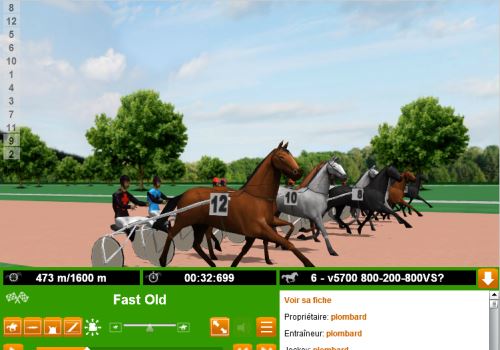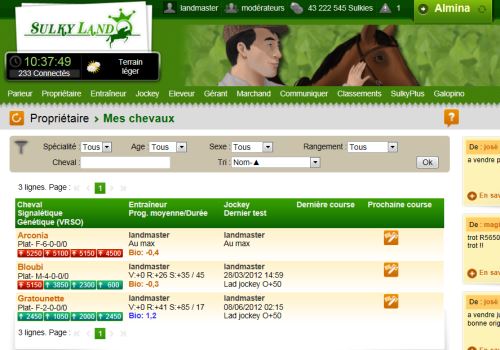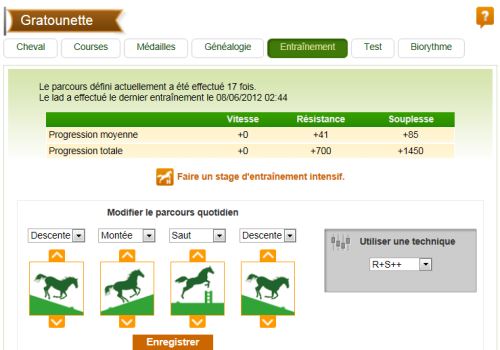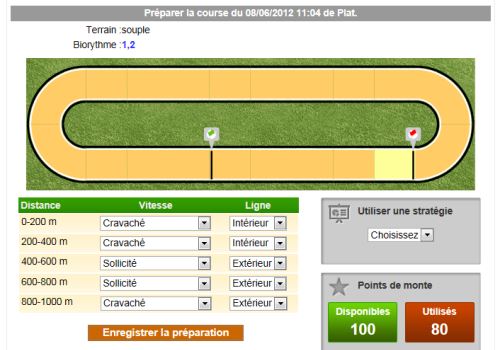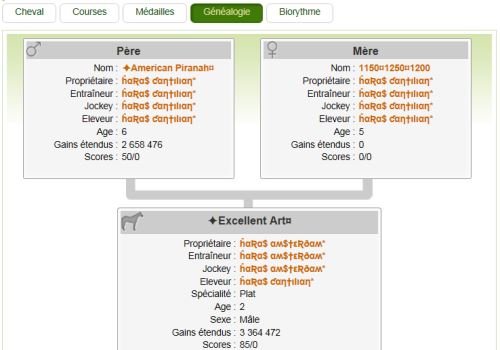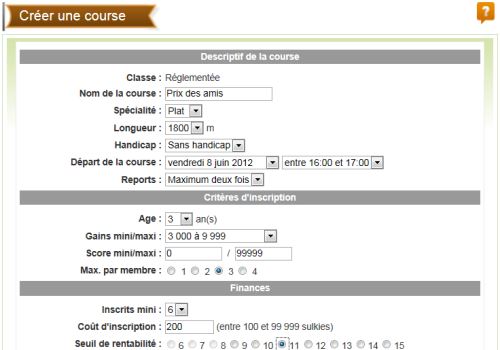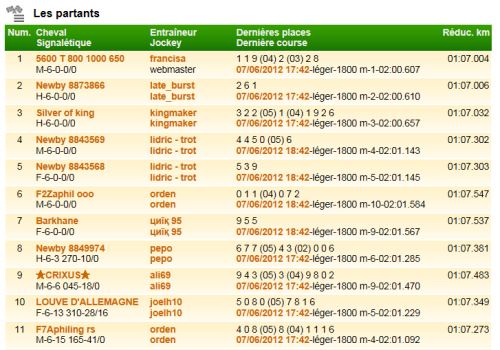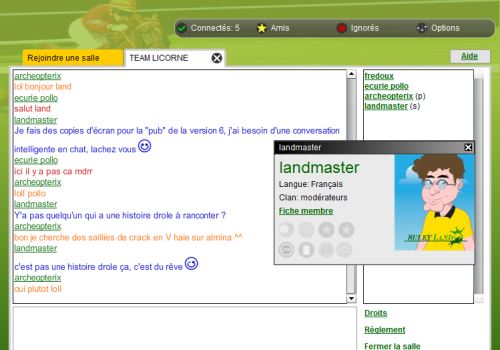Les chevaux
The main goal of Sulkyland is to build a good stable. Understanding the characteristics of the horses and the way results of the races are determined is essential.
Name
Each horse has a name which belongs only to him on the game. If it's difficult for you to find an unusual name, you can choose a suffix to identify horses of your breeding (page "Username" - "My account" - "Change my options"...). Like that you won't have limits anymore, except choosing a single name by horse of your breeding.
Speciality
There are no real breeds on Sulkyland, horses are grouped in racing specialities (flat, hurdle or trot). You can only cross horses of the same speciality.
The career of the horses starts from their birth (they are one year old) and lasts until their usual retirement (when they reach to the age of 17) or until you decide to retire them, whatever their age. On the game, horses take one year every month (born on January 1st, he will be 2 years on February 1st, 3 years on March 1st...).
If you retire a horse by mistake, you can make him go back to competition again going to the page "Buy/Sell" - "Sell a horse". Search the line of your horse, then click on the link "Retired".
Genetics
The basic capacities of the horses are defined by genetics.
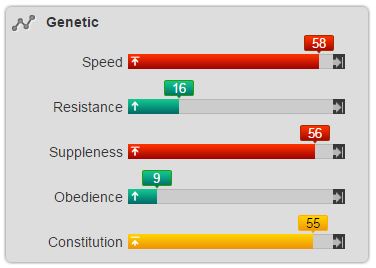
The speed is the main characteristic, it is the speed he runs without getting tired.
The resistance is the horse's ability to go faster than his basic speed. The more resistant the horse is, the more he can go faster for a long time.
The suppleness is the ability to adapt to the turf (dry, soft...). A good suppleness will also diminish risks of falling in hurdle races. A good suppleness gives to your horse ability to start and change of speed too, so it can make him start faster at the beginning of the race for example.
The obedience is the horse's ability to apply the jockey's orders. The more obedient a horse is, the steadier his results will be. A good obedience will also diminish risks of fault in trotting races.
The constitution exists on Chorus only, it defines the horse's ability to progress more or less quickly when trained.
At birth, a horse already has a minimum in each of these characteristics. On Almina and Bezir, speed, resistance and suppleness increase according to the training, and obedience increases by testing the horse. On Chorus, all the characteristics progress thanks to training.
The colour and symbols of the genetic graph indicates if a horse is far of his maximum, near it or if he reached it. In the example here above, the horse is at his maximum speed and suppleness, near his maximum constitution, and can still increase his resistance and obedience by at least 5 points.
Each month (each generation), the genetic value of the horses that are born increases. For example, one month the attainable maximum for a horse just born will be 62, and 6 months later it will be 63 for the new borns. In order the races' results remain similar from a generation to another, the genetic value used to calculate the race's results is reduced to a number remaining stable through the months. A 6 years-old horse who would have 63 in 6 months will thus have the same capacities than a 6 years-old horse having 62 this month.
There are 2 biorhythms. The resistance biorhythm, which permits to adjust your running strategies, and the speed biorhythm, which gives a variation to the basic speed of your horses.
Biorhythm is not known before the horse birth.
On Chorus:
Both biorhythms are showed, and progress according what you do with your horses. Each point represent an action which impacted the biorhythm (training, race or test).
Their values range from -1 to +1.
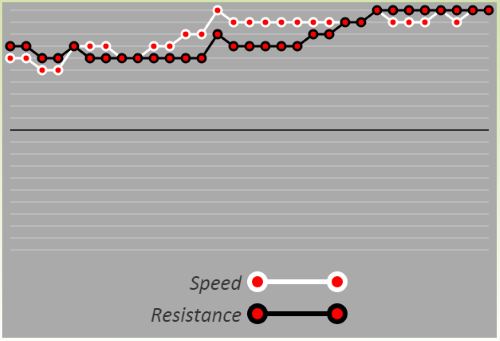
The attitude of the 2 curves depends on training first. Some courses make the biorhythm decrease or increase for speed and/or resistance. It's up to you to discover them.
But each race (and each test in the same way) makes the biorhythm move, on a simple principle : if during the race you run, the whip points of your horses were well used, the biorhythm rises. If you under or over-exploited your horse, it decreases. For example, this means that a horse who can run 1600m whipped all along will lose biorhythm if you make him run only 1000m, as you won't have used all his whip points.
A fall in hurdle can make both biorhythms decrease strongly.
On Almina and Bezir:
You can only see the biorhythm of resistance, and both biorhythms change each hour according to a regular curve (with a period of several days).
The biorhythm of resistance ranges from -1.2 to +1.2, but some horses can never have a biorhythm higher than 0, or on the contrary they can never have a biorhythm under 0. A horse with "0" is in a normal fit. A horse with a negative biorhythm will have less resistance than usual, and a horse with a positive one will have more resistance. If you keep a record of the curve every day, you will discover that it is periodic, so you can suppose when your horse will be at his maximum and define a strategy to enroll him in races.
The biorhythm of speed is not shown but you can try to study it (to foresee the phases of best form of the horse) comparing the evolution of the racing times or the times of tests of each horse.
Other parameters having an effect on the results in races
For equal genetic capacities, there are other parameters to make the difference between 2 horses :
- age: the speed of the horse receive a bonus which depends on age. The speed improves a little during the first year, improves faster between 2 and 3 years old, then starts to steady, to decrease from 6-7 years.
- tiredness : a horse having run less than 3 hours ago is penalized.
- and of course the jockey's strategy, and its consequences (see the chapter about jockeys).
The type of turf (dry, soft...) has an influence on all the horses (if the turf is heavy they go slower than if is it's dry), but a good suppleness of the horse reduces this negative influence.
In a handicap race, the handicap attributed to a horse will have a particular influence on him.
Scores
A horse's scores are calculated depending on his race results.
There is the "basis score", calculated on reglementary races without handicap and the "score with handicap" calculated on the reglementary races with handicap.
When a horse finishes first, he wins 5 points. When it's second, he wins 4 points... fifth he wins 1 point.
He loses a score point for each less scored horse finishing before him.
He wins a score point for each better scored horse finishing after him.
Kilometric reduction
After each race which length is between 1000 and 4000 meters, the balanced kilometric reduction of the horse is calculated. The purpose of this reduction is to have a reliable data of comparison whatever the weather, the length of the race or the speciality. The program keeps the best reduction over the last 30 days. When a record reduction has more than 30 days, a new one is calculated on the first race the horse will run.
The balanced reduction is calculated in the following way:
- time carried out is brought back to a time "with the kilometer" (time on a race of 3000m for example is thus divided by 3).
- this time is then reduced compared to the average speed related to the length of the race (the average speed on a race of 3000m is lower than that of a 1000m, time for example is thus divided by 1.2).
- this time is then reduced compared to the weather’s conditions (the average speed on a muddy ground is lower than the one on dry ground, time for example is thus divided per 1.13).
- this time is last once reduced compared to the type of race (the average speed on a trotting race is lower than on a flat one, time for example is thus divided per 1.16).
Every time you see the name of a horse, you just have to click on it to consult his card.
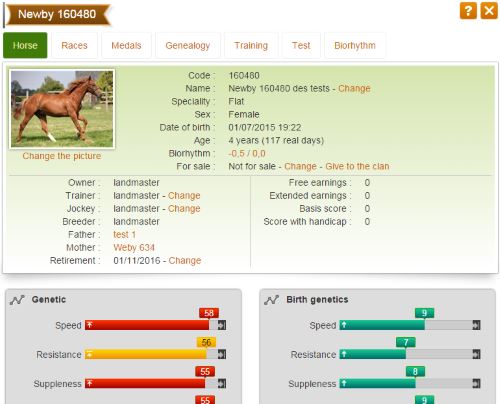
The card is organized into tabs, the "horse" tab sums up the horse basic information.
If you are the owner, trainer or jockey of the horse, you will have supplementary tabs and links compared to a horse not related to you.
You can change the name of a horse from this card.
If it's a male, you can neuter him (turn him into a gelding), that will give a little bonus to his running potential.
You can consult the current genetics of the horse, as well as his birth genetics. Hover your mouse over the right border of each genetic bar to see the maximum for horses of the same age.
You can use the horse card or the links available on other pages of the game to do the following things: change the sale parameters of a horse, change his trainer or jockey, retire him, define if you want genetics (and biorhythm) to be public (visible for everybody at any time), reserved to your clan members or to the horse's team (owner, trainer and jockey).
After creating storage units in the page "Username" - "My storages", you can allocate a horse to a storage and thus easily filter the lists of horses in the owner, trainer, jockey or breeder modules.
You can use the writing pads to save information in relation to your horse, either for your personal information, or for the team who manage the horse, or for all the players.
Races
The tab "Races" gives you all the history of a horse's races.
A chart makes a synthesis of the horse's results.
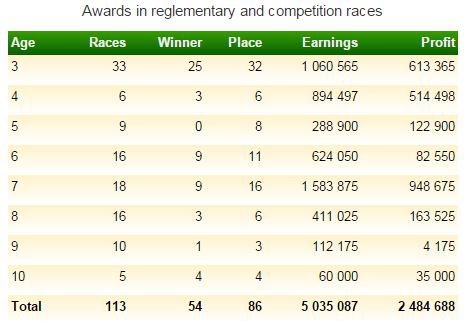
The column "Races" gives you the number of races (excepted "free" races) he run, by age. The column "Winner" indicates you the number of times he arrived first. The column "Place" indicates the number of times he arrived in the first three.
Medals
The tab "Medals" shows all the medals won by the horse. You have to take part to competitions to win a medal (see the chapter "Competitions").
Genealogy
The tab "Genealogy" gives a synthetic view on the horse's parents and offspring.
Changing the picture
You can change the picture illustrating the horse card. To show respect for other players, we only ask you to favour photos of real horses (even if the coat colour of the photo is different of the colour on the game).
We furnish you 18 basic photos, but you can use the link "Add a picture" to add a photo you have on your computer.
Sell
There are 3 kinds of sales:
- fixed price: the horse will be bought by the first to accept the wanted price.
- reserved sale: the horse can only be bought by the player whose username you chose.
- auctions: the horse will be sold to the player who have proposed the higher bid at the end of the auction.

